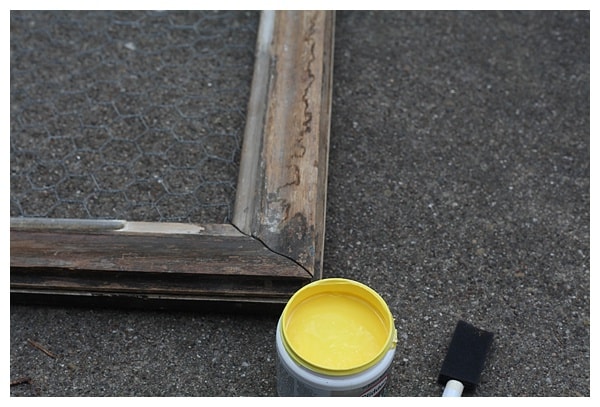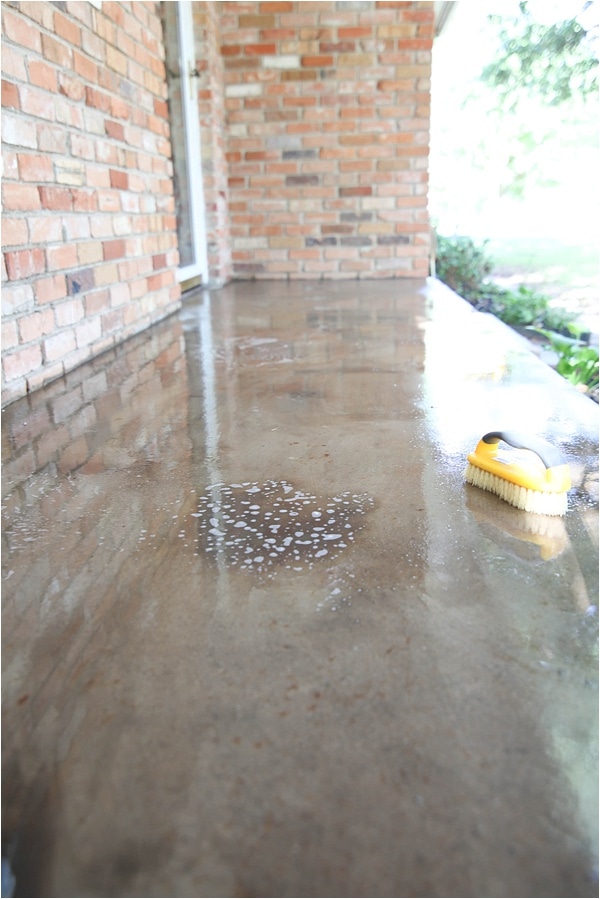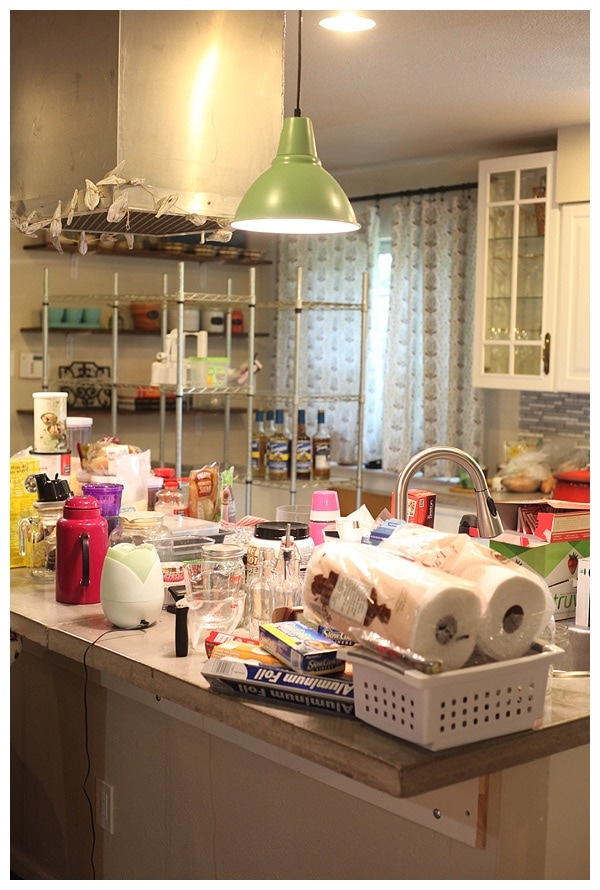Dishwasher Care 101: How To Clean Your Dishwasher
Some links in this post are affiliate links, which means I receive a commission if you make a purchase (at no additional cost to you). Thank you for your support!
Want a quick and easy way to clean your dishwasher? You’re in the right place! If your dishwasher smells less than ideal, cleaning it and getting it back in tip-top cleaning condition is easy.
Here are step-by-step instructions on how to clean your dishwasher, cleaning schedules to stay on top of maintenance, plus expert tips for the perfect clean every time (some will surprise you!).
Why Bother Cleaning Your Dishwasher?
First off, why should you clean your dishwasher? It seems odd to clean something that’s supposed to be clean.
But here’s the thing – dishwashers can accumulate food debris, grease, and soap scum over time. This affects its efficiency and can also be a breeding ground for bacteria and mold. Yuck! Plus, a clean dishwasher equals cleaner dishes. It’s a win-win.
The only confusing thing is, how do you clean it? Most people are familiar with how to clean a microwave, oven, or other cooking appliances, but dishwashers are a bit of a mystery. Here, I tell you everything you need to know.
Psst…struggling to keep your house picked up? Then you need to read this post about 6 ways to get your home clean—and keep it that way forever!
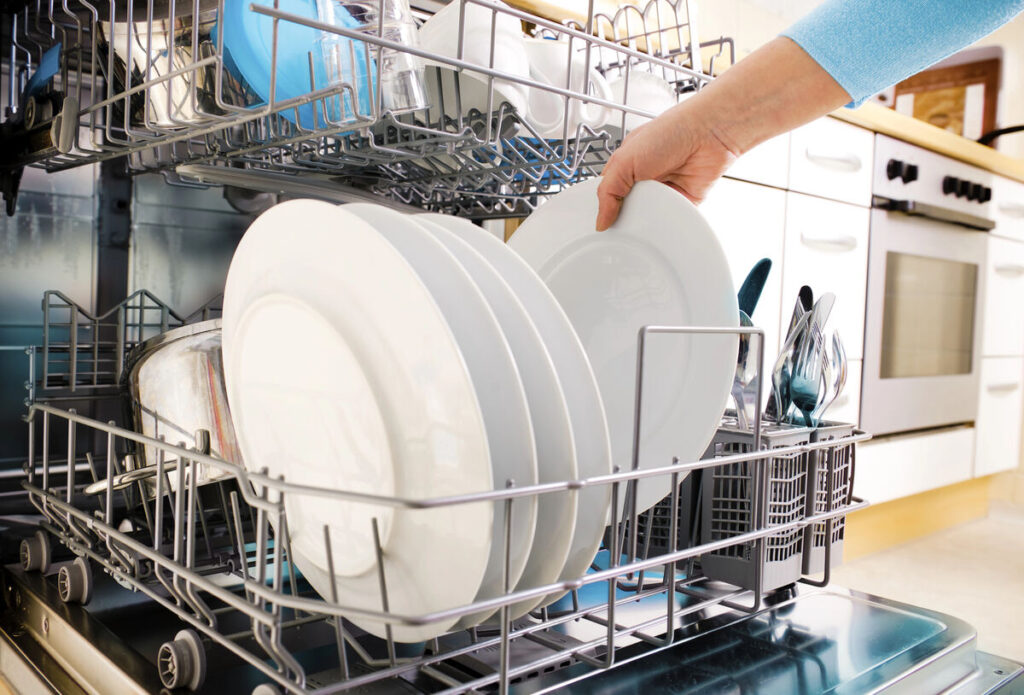
What You’ll Need
You’ll need a few essential items to get your dishwasher sparkling clean. Here’s a quick list to help you gather what you need:
- White vinegar: Great for breaking down grease and deodorizing. Vinegar is a versatile, powerful natural cleaning agent. It can even be used to clean a hairbrush, bathrooms, sinks, and dirty dishes.
- Baking soda: Useful for removing stains and freshening up.
- Soft brush or toothbrush: Helps scrub the nooks and crannies, especially around the filter. Tip: always keep old toothbrushes. They’re handy for many other small jobs, like cleaning a razor, sinks, and bathroom nooks and crannies.
- Dishwasher-safe bowl or cup: Needed for the vinegar cycle.
- Cloth or sponge: For wiping down the interior and exterior.
- Dishwasher cleaning tablets (optional): Handy for a thorough clean.
How Often Should I Clean My Dishwasher?
Maintaining a clean dishwasher is easier than you think! Just follow this simple routine:
- Monthly: Clean the filter to keep it unclogged.
- Every few weeks: Wipe down the interior and door seals for freshness.
- Every 1-2 months: Use vinegar and baking soda for a thorough, deep clean.
For detailed instructions on each step, read on and discover how to keep your dishwasher in top condition!
How To Clean Your Dishwasher: Step-By-Step Instructions
Step 1: Empty Your Dishwasher
Start with the basics: ensure your dishwasher is completely empty. You don’t want your coffee mugs getting in the way of your deep cleaning mission.
Step 2: Clean the Filter
Most dishwashers have a removable filter at the bottom. This little guy catches food particles and needs regular cleaning to keep things running smoothly. Twist it out, rinse it under hot water, and scrub it with a soft brush if needed.
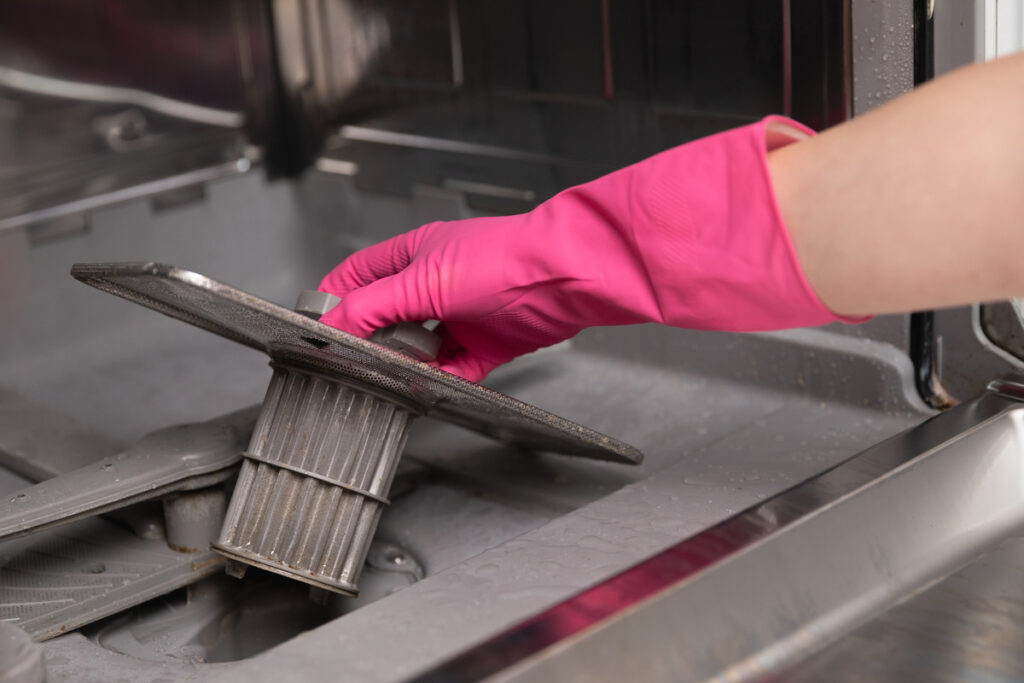
Step 3: Unclog the Spray Arms
The magic happens in the spray arms – they spray water to clean your dishes. Over time, their holes can get clogged with food particles. Remove them if possible and give them a good rinse. Use a toothpick to unclog the holes. Trust me, it’s oddly satisfying.
Step 4: Wipe the Interior
Next, wipe the dishwasher’s interior, including the door, with a damp cloth. Focus on the seals and any nooks and crannies where grime might hide. No need for harsh chemicals – a mix of warm water and baking soda does the trick.
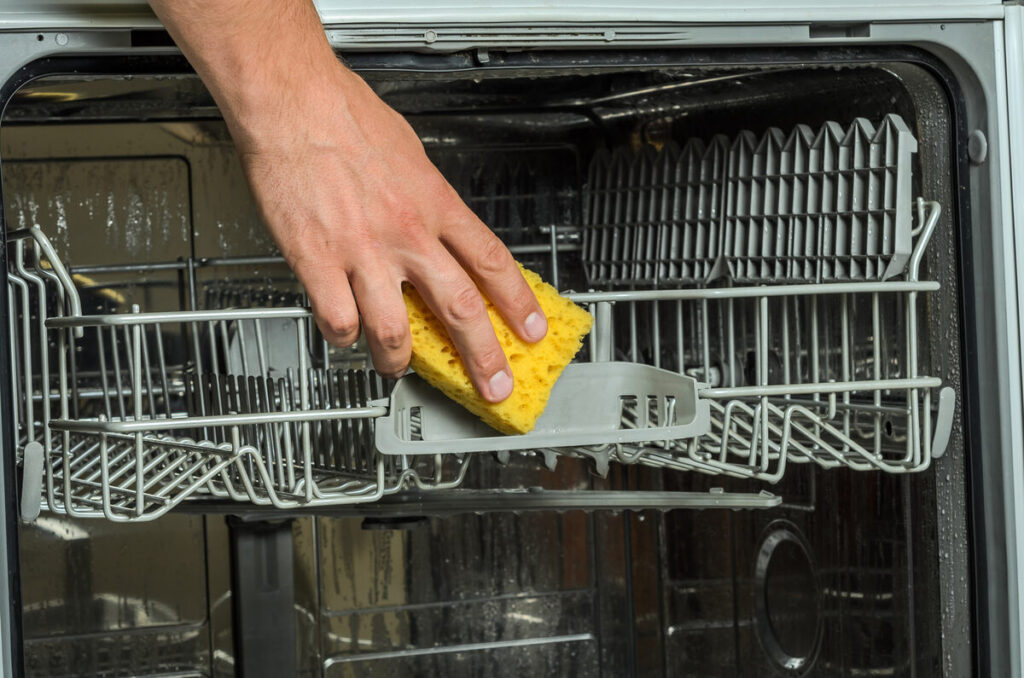
Step 5: The Vinegar Wash
Vinegar is like the superhero of household cleaning. Place a dishwasher-safe bowl filled with white vinegar on the top rack and run a hot-water cycle. The vinegar will break down any lingering bits and deodorize your machine.
Note: Just don’t mix vinegar with bleach – it can create dangerous fumes.
Step 6: Baking Soda Rinse
After the vinegar wash, sprinkle a cup of baking soda across the bottom of the dishwasher and run a short cycle. This helps in removing stains and leaves your dishwasher fresh.
Step 7: Clean the Exterior
Remember to clean the outside of your dishwasher! Wipe the control panel and exterior with a damp cloth. If you have a stainless-steel dishwasher, a glass cleaner can add that extra shine.
Step 8: Monthly Maintenance
Aim to clean your dishwasher once a month. Regular maintenance can extend its life and improve its performance.
I’ve Cleaned My Dishwasher, but It’s Still Not Working Well – Now What?
Here is a quick checklist to run through with additional tips and troubleshooting options:
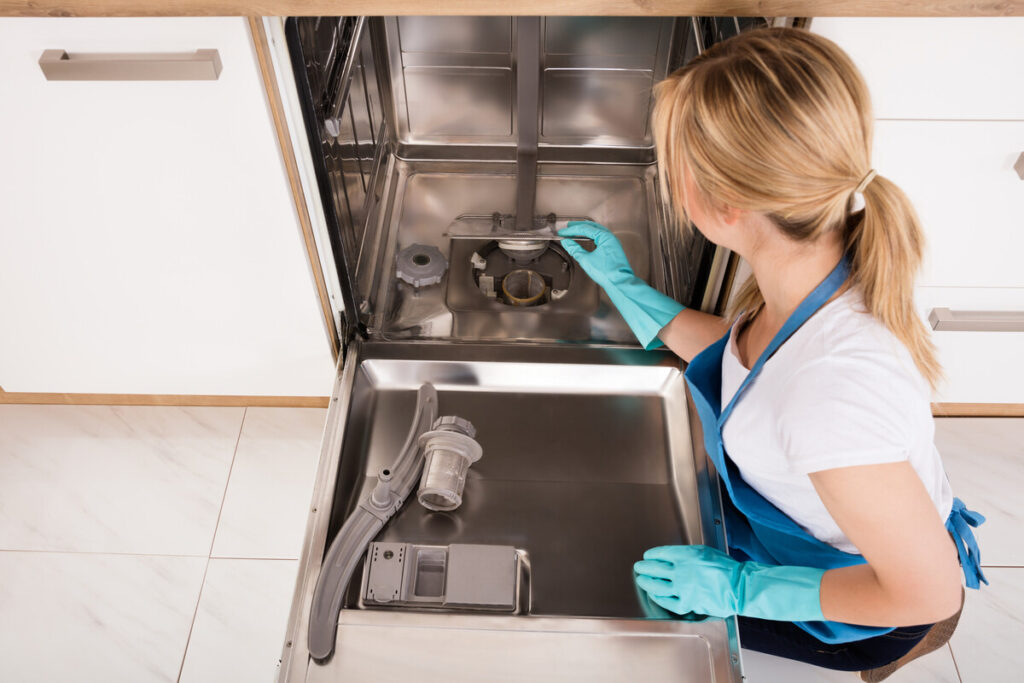
Additional Tips
- Check the Drain: Make sure the area around the drain is debris-free.
- Rust Removal: A dishwasher-safe rust remover is your go-to if you spot rust.
- Use the Right Detergent: Experiment with different detergents if you notice residue.
- Load It Right: Proper loading can prevent food particles from getting trapped.
- Regular Use: Regularly using your dishwasher can prevent buildup.
Troubleshooting Common Problems
- Dishes not cleaning well? Check if the spray arms are clogged.
- Bad smell? Regular cleaning and leaving the door ajar can prevent odors.
- Dishwasher not draining? Check the drain and ensure it’s not blocked.
If you’ve tried all of the above and your dishwasher still isn’t giving great results – don’t rush out to buy a new one. Some simple solutions might surprise you and immediately improve your dishwasher’s performance. But first, let me quickly explain some essential information about how your dishwasher works for context.
North American vs. European Dishwashers
First, it’s important to note that North American and European dishwashers differ, mainly in their water-heating mechanisms.
North American models typically connect to an external hot water supply, while European (and Australian) ones heat water internally. This difference affects cleaning efficiency and the approach to dishwasher use.
If you live in North America, the first expert tip below will be a game-changer. But before we get into it, let me quickly explain how dishwashers work.
How Do Dishwashers Work?
Dishwashers are nifty machines. Here are their key features and how they work:
- Water Source: The dishwasher connects to your home’s hot water supply.
- Heating: Some dishwashers further heat the water for effective cleaning.
- Detergent Dispensing: An emulsifier is released to break down grease and food particles.
- Spray Arms: These spray the detergent-water mix over the dishes.
- Macerator: In some dishwashers (not all), a macerator grinds down food particles, preventing larger debris from clogging the system.
- Filter: The filter traps residual food particles during the cycle.
- Phases: The dishwasher goes through timed phases of cleaning, outlined below.
Here’s What Happens When You Turn On Your Dishwasher:
- Prewash Phase: It starts with a prewash, sprinkling water to loosen up food scraps or grime.
- Main Wash: Then, the main wash begins, where hot water mixed with detergent gets to work, tackling the tough stains and grease.
- Rinse Cycle: After the wash, it rinses off the suds and any lingering food particles, ensuring your dishes are spotless.
- Drying: Finally, in the drying phase, heat or a fan is used to dry your dishes, leaving them ready for your next meal.

What Does Detergent Do?
Dishwashing detergent is critical to effective cleaning in a dishwasher—this hardworking cleaning solution does quite a lot!
While water alone can remove some dirt due to its abrasive nature, it’s not enough for oily or greasy residues. Detergent acts as an emulsifier, breaking down fats and grease and washing them away. It also suspends food particles, preventing them from resettling on dishes.
Water would only partially clean without detergent, leaving greasy and oily items dirty. The detergent’s role is crucial for thorough, hygienic cleaning.
Expert Tips for Sparkling Clean Dishes
Tip 1: Run Your Faucet Before You Run Your Dishwasher
It can take a minute or two for hot water to reach your faucet, and as your dishwasher is connected to the same pipes, it also takes some time before it receives hot water. Therefore, North American dishwashers’ first rinse cycle will often start with cold water if hot water isn’t immediately available. This can significantly impact cleaning performance. Imagine washing dishes by hand with cold water! It simply won’t get the job done as well.
Luckily, there’s a simple solution here – to optimize your dishwasher’s performance, let the kitchen faucet run until hot water flows before starting the dishwasher. This simple step ensures the appliance has immediate access to hot water, which is crucial for effective cleaning.
Tip 2: Use Powder Detergent and Skip the Expensive Tablets
Yes, you read that right. Dishwashing detergent brands would love to have you believe you need to pay premium prices for your dishwasher to work well. But, the reality is that traditional loose powder or gel detergents, even the basic, less expensive ones, are all you need and can be highly effective.
Dishwashing tablets were invented as a convenience product to save people from measuring the detergent. We have come to think of them as a superior product. Still, they are simply a modified version of the original – a pressed powder or loose powder in a soluble membrane.
The disadvantage of tablets is that they can only fit in the main wash compartment, which is not released until the primary wash cycle. This means no detergent is in the prewash compartment; therefore, no detergent is removed in the first prewash cycle.
For optimum cleaning potential, it’s more effective to have detergent available throughout the entire cleaning process. In short, use a loose powder or gel to fill the prewash and main compartments on your dishwasher for the best results. Note: you cannot use regular hand dishwashing detergent as it will foam up and leak from your dishwasher.
If you really love the convenience of dishwashing tablets, then use two: place one in the main compartment and throw another into the bottom of your dishwasher. This way, there is detergent available in the prewash cycle. It’s a more expensive way to do it, but if you’re attached to your tablets, this will get your dishes clean.
Regular Maintenance and Troubleshooting
Monthly Maintenance Tips
Regular cleaning keeps your dishwasher in peak condition, including filter maintenance, unclogging spray arms, and using cleaning agents like vinegar and baking soda. Monthly deep cleans prevent buildup and maintain efficiency.
Addressing Common Dishwasher Problems
Issues like poor cleaning quality or odors often stem from neglecting regular maintenance. Regular cleaning, proper hot water usage, and correct detergent application can solve many problems.
When and How To Use Specialized Cleaning Products
While the vinegar and baking soda method is highly effective, specialized dishwasher cleaning products can also be used for convenience. Follow manufacturer instructions for use.
FAQs:
Can I use bleach to clean my dishwasher?
No, do not use bleach, as it can damage your dishwasher. The vinegar and baking soda method is effective without needing harsh chemicals.
How often should I clean my dishwasher?
Aim to clean your dishwasher once a month to keep it running smoothly and smelling fresh.
Can I run the dishwasher empty?
Yes, running it empty with vinegar or baking soda helps clean and deodorize it.
How To Clean Your Dishwasher and Pro Tips for Sparkling Dishes
Well, there you have it – your step-by-step guide to keeping your dishwasher in tip-top shape. If you’d like to know more, check out this very informative YouTube video, which helped provide some of the information in this article. A clean dishwasher is more hygienic and runs more efficiently, saving you time and money in the long run. Remember, a little care goes a long way. Happy cleaning!
This article originally appeared on Wealth of Geeks.
Liz Douglas
Liz Douglas is a former product developer and food buyer turned plant-based foodie influencer, recipe developer, writer and podcast host. After developing food products for some of the world’s largest retailers like Coles and Kaufland, she now applies her recipe development skills to wholesome plant-based twists on classic comfort foods. She shares recipes, plus wellbeing, productivity and lifestyle content on her website Glow Diaries: a conscious guide to good living. Her work has been featured in Herald Sun, Instyle Mexico, PETA Australia, Channel 10 Australia and Nourish Magazine. You can follow Liz @glowdiaries___ on Instagram, TikTok, Facebook, YouTube and Pinterest. Listen to her podcast Thrive Diaries on Spotify, Apple Podcasts or your podcast player of choice.

